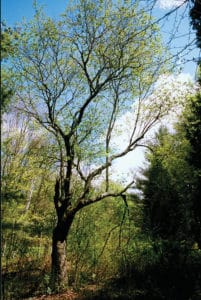By Gary Salmon
People have always been interested in “big trees.” That is, those that catch our eye and inspire majesty and curiosity in us. The redwoods of California have been the “must see” trees since our country was settled and still attract millions of visitors annually. However each state, including Vermont, has its own set of big trees and for years people have searched for not only large trees but the largest trees of each species. Jeff Freeman, a botany professor at Castleton University, started Vermont’s big tree effort in 1973, and the list included 27 trees. It grew quickly and in 1977 had 75 trees and then grew to 81 in 1982. It has since grown to 114 in the early 2000s and today about 150 species are under consideration. In 1940 American Forests developed a National Register of Champion Trees which is the standard for the big tree program nationwide and includes the measuring system used to register trees and assign points to them based on circumference, height, and crown spread. This national list of big trees exceeds 800 species.

This shadbush in Clarendon is one of the state’s largest.
The Vermont Big Tree Program has been such a wonderful way to connect people and trees and the list has been supported over the years by multiple organizations and many people. One only needs to view the big tree display located inside the forestry building at the state fair each year to see that people/tree connection. Unfortunately the big tree program has been mostly dormant for about a decade as the trees and those who measure them got older and as both slowed down as the aging process continued. However, last year the Vermont Urban & Community Forestry Program began working on updating the Vermont big tree program by breathing new life into the old list. Information was examined on 150 trees and 53 trees are now verified on the updated list. And this will no longer be simply a dropdown list nor in booklet form but a searchable database with images, measurements, total points by tree and location information. All data is collected through ArcGIS Survey123, displayed through ArcGIS Experience Builder, and is searchable and sortable. For example, one can now search for trees by species or genus and sort by county, by size, or by trees that are publically accessible. To see the tree information on the 53 Vermont trees listed, search “Vermont big tree list.”
So where do you fit in? The list is far from complete and will be constantly changing as new big trees are discovered. My first scan of the new list revealed that the former Vermont Big Tree Champion cottonwood in Hubbardton has been replaced by a cottonwood in Colchester and the former state black locust in Pittsford has been replaced by one in Milton. If there is a big tree in your life, nominate it. Remember it is not “the largest tree in Vermont” but the largest tree of each species that makes the list. So while the largest tree in Vermont is the Colchester cottonwood (447 points) the national champion tree from Vermont is the round leaf shadbush in Clarendon (114 points). Nomination forms with instructions can be found on the Vermont big tree list website. To ease the workload the format for nominating and measuring has been “standardized” somewhat by having nominations accepted between January and July of each year with follow up measurements done between July and December. Further information on this latest big tree effort will be published this spring. There might be a big tree in your life.




